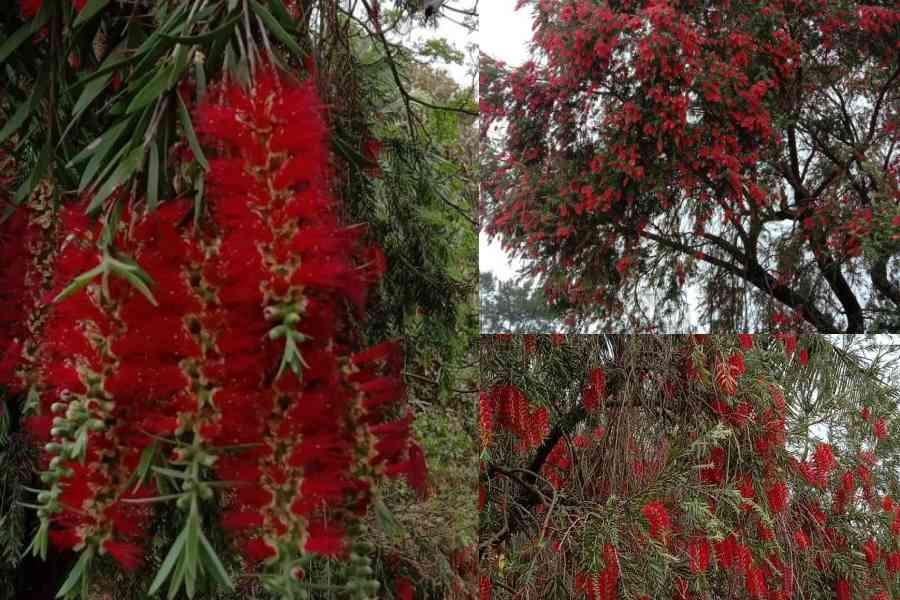The brush that one inserts inside bottles to clean them. Yes, this plant is named after something rather prosaic but its beautiful flowers can evoke poetry.
The Bottle Brush Plant, also known as Callistemon, is a tree with bright flowers that have a cylindrical, bottle brush-like appearance. It is a genus of flowering plants in the family Myrtaceae (clove, guava etc). The flowers are usually bright red, but they can also be also found in other colours such as pink, yellow, or green. Flowers bloom sporadically throughout the year in frost-free areas, but more typically in spring in hot climates.
Bottle Brush Plants are commonly used as ornamental shrubs or small trees in gardens and landscapes. They are particularly valued for their vibrant flowers. Up to 35/40 individual flowers grow on very long, bushy stamens. Flowers are attractive to birds, bees, and butterflies. The flowers also make excellent cut flowers for floral arrangements.
These plants are native to Australia, although they are cultivated in other parts of the world for their attractive flowers and foliage. The plant has narrow, lance-shaped leaves that are characteristically dark green and glossy. Leaves have a lemony scent when bruised. The trees often have a black trunk and white branches. The species name means “related to citrus”, referring to the fragrant leaves. These plants are very tolerant of pruning and old plants will regenerate if pruned back hard into the old wood.
Bottle Brush Plants can vary in size, ranging from small shrubs to small trees, depending on the species and cultivar. They usually have a dense, bushy growth habit. There are around 40 species of Callistemon, with various cultivars available in the horticultural business. Some species of Bottle Brush Plants are suitable for growing in containers. Some popular species and cultivars include Callistemon Citrinus or Crimson Bottlebrush, Callistemon “Little John” (Dwarf Bottlebrush), and Callistemon Viminalis or Weeping Bottlebrush.
These plants thrive in warm, sunny locations. They are adaptable to a range of soil types but prefer well-draining soil. Bottle Brush Plants are generally drought-tolerant once established, but will benefit from regular watering during dry periods.
Light and temperature
Bottle Brush Plants need full sun, that is six or more hours of direct sunlight a day. In its native Australian habitat, the plant can tolerate above 45 degrees Celsius. Bottlebrush tolerates very dry conditions too.
Soil
The soil should be moist, rich, and fertile with high organic matter. Mix soil with organic material if necessary. It should also drain well. Add sand or other material that will improve drainage for sure. Soil should be acidic or pH should be less than 6.
Water
It’s important to water a newly-planted shrub regularly for establishing strong roots. The Bottlebrush has some drought tolerance, so we one doesn’t need to water it regularly. It will survive dry conditions but thrives with weekly watering during hot weather.
Fertiliser
Use a balanced fertiliser (N:P:K -19:19:19) on Bottle Brush Plants in spring. To promote flowering, use a liquid fertiliser (fish emulsion or mustard emulsion) a few times throughout the growing period. Avoid fertiliser higher in nitrogen, which will promote leaf over flower growth.
Diseases and pests
This plant is not affected by any known insect or disease problems but root rot can be an issue if it doesn’t have good soil drainage. Watch for spider mites and scale, particularly on indoor plants. Leaf yellowing can occur when the soil is high in alkaline or salt.
Care
Bottle Brush Plants are relatively low-maintenance. Pruning is usually done to maintain a desired shape or to remove dead or damaged branches. Prune after flowering to promote new growth and encourage a more compact form.











